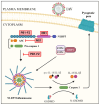Host Innate Antiviral Response to Influenza A Virus Infection: From Viral Sensing to Antagonism and Escape
- PMID: 39057788
- PMCID: PMC11280125
- DOI: 10.3390/pathogens13070561
Host Innate Antiviral Response to Influenza A Virus Infection: From Viral Sensing to Antagonism and Escape
Abstract
Influenza virus possesses an RNA genome of single-stranded, negative-sensed, and segmented configuration. Influenza virus causes an acute respiratory disease, commonly known as the "flu" in humans. In some individuals, flu can lead to pneumonia and acute respiratory distress syndrome. Influenza A virus (IAV) is the most significant because it causes recurring seasonal epidemics, occasional pandemics, and zoonotic outbreaks in human populations, globally. The host innate immune response to IAV infection plays a critical role in sensing, preventing, and clearing the infection as well as in flu disease pathology. Host cells sense IAV infection through multiple receptors and mechanisms, which culminate in the induction of a concerted innate antiviral response and the creation of an antiviral state, which inhibits and clears the infection from host cells. However, IAV antagonizes and escapes many steps of the innate antiviral response by different mechanisms. Herein, we review those host and viral mechanisms. This review covers most aspects of the host innate immune response, i.e., (1) the sensing of incoming virus particles, (2) the activation of downstream innate antiviral signaling pathways, (3) the expression of interferon-stimulated genes, (4) and viral antagonism and escape.
Keywords: ISGs; JAK-STAT; NLRP3 inflammasome; NOD-like receptors; RIG-I; Toll-like receptors; ZBP1; antiviral therapies; genetic variants; influenza virus; interferons; single-nucleotide polymorphism.
Conflict of interest statement
The authors declare no conflicts of interest.
Figures







References
Publication types
MeSH terms
LinkOut - more resources
Full Text Sources
Medical

